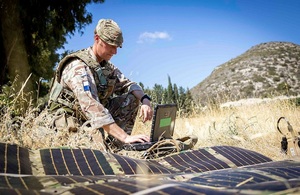Sustainability – how to achieve operational advantage
Chief of Defence Logistics and Support, Lieutenant General Richard Wardlaw on why sustainability is the means to achieving operational advantage in the future.

The following is an article written by Lieutenant General Richard Wardlaw, Chief of Defence Support and Logistics (CDLS), part of Strategic Command. Lt Gen Wardlaw was appointed as the first CDLS in 2019 and since then has developed, cohered and assured the support function for Defence. Strategic Command continually delivers impactful capabilities for Defence, deployable at a time and place of our choosing. Embracing green and sustainable technologies is a critical part of this.
When talking to Russia’s illegal invasion of Ukraine, US General Ben Hodges recently commented that ‘Wars are a test of logistics and will’. This remains as true today as it has throughout the history of warfare. Our ability to sustain operations away from the home base, to ensure those on the frontline have the kit, equipment, and sustenance they need to operate, has always been critical to whether you are successful or not. If you cannot get to the fight and stay in it, then there is no fight.
But what might this future look like? I share a fictitious ‘letter’ from 2032 to a Formation Commander back in the UK.
Dear General,
As I reach the end of our 12 month deployment I wanted to update you on the significant part the British Army has played in supporting the wider NATO mission to secure the peace between two warring factions.
Despite the distractions of fighting by proxy a major war and the challenges with what turned out to be the longest post-war recession, it was the direction over a decade ago to ruthlessly embrace the opportunities for sustainability in responding to the existential crisis posed by climate change which has ultimately delivered the profound operational advantages we enjoy today.
The deployment of our first micro nuclear generator has allowed us to service the needs of the 5,000 troops stationed here and our electric/hybrid vehicle fleet. And it has released the force from protecting the logistic tail to service the diesel generator farms of old – by my rough calcs that’s over 3 million litres of diesel which we have not had to move this year alone. In Afghanistan and Iraq over 60% of our causalities were taken enabling and protecting such convoys.
Combining these reactors with the new portable air capture units has allowed us to produce in situ our own synthetic fuel for all deployed heavy vehicles and supporting aviation without any net contribution to CO2 emissions. Needless to say, the most recent European wide drought and local 3-month spell of constant daytime temperatures above 40 degrees has reminded us all of the cost of missing the 1.5 degree limit. Bring back the summer of 2022 – it was a breeze!
We’ve also played a key role in establishing the UK’s first operational vertical farm. We now get a chunk of our carbohydrate and all our greens and fruits from these units – and the farm occupies a space less than half a football pitch! The water they use is constantly recycled and the energy demands are trickle fed by the integrated solar panels during the day and by night switch through our Smart Grid technology to nuclear. We’ve reduced fresh food movements by nearly 70% - the RAF tell me that it’s great to be moving more people than carrots! I’m not sure all the soldiers are quite as keen as the General on the plant-based diet we’ve largely adopted, but the in-situ processing unit we built means we’ve reduced frozen meat movement to near zero.
The development of ‘Factory in a Box’ deployed ISO units has finally come of age – the direction taken to design into our kit the need for parts to be 3D printable has made a huge difference to the deployed inventory. Comd 101 Logistic Bde was telling me the other day that movement of inventory is reduced by nearly 40%. And of course, our equipment fitters no longer have to wait out on priority demands that never arrive – so equipment availability has shot up.
I’ve saved the best for last – the introduction of the new directed energy weapon systems into the Brigade Combat Teams allied to ready access to energy means we can, in effect, produce our own ammunition in situ – crazy, I know, but reducing the volume of ammo we have to store and then move has liberated the GOC in terms of planning force movements.
Of course, all of this is in stark contrast to our adversaries over the border. I suspect they are ruing the decision they made to cancel all the investments they were making in electrification and green technology to prioritise their immediate battles. They are still catching up. Our intelligence colleagues who are tracking this stuff, reckon every litre of fuel by the time it reaches their forward locations costs over $100/litre – and that’s when they can get it! They continue to be fixed by logistic considerations when it comes to operational manoeuvre.
Who would have thought that sustainability would be the solution to the future force not an imposition? Well, thank goodness our predecessors did! UK Defence has led the charge – with a deployed force that can live, move and fight like never before.
On that note I’ll sign off.
Of course, the future of military campaigning I paint here (to be clear, it is a fictional one!) is one that is to a very significant and conscious degree shaped by the introduction of sustainable, green technologies. I have not attempted to describe in any great detail the other changes in campaigning that will be introduced by the digitisation of Defence more widely. For example the widescale adoption of autonomy, robotics, Artificial Intelligence and Machine Learning.
But that in itself is my point. Attractive, headline catching and indeed potentially ‘game changing’ as some of these technologies may be, I passionately believe that the adoption of more sustainable, green technologies alongside these developments are central to providing operational advantage to the future force. A future where environmental technologies become the means for a revolution in military campaigning. One in which the emphasis shifts from logisticians planning to sustain at reach, to scientists and engineers designing for self-sustainment.
If war is ultimately the most visceral of competitions, imagining a future in which our superior capabilities can be brought to bear faster, for longer, and at a time and place of our choosing, not one dictated by the physical constraints of our supply chain or a climate-changed world, is a future we should all aspire to.
Background
The Defence Support organisation’s priority is providing support to current operations. But much of its work is about making improvements to how we support our Armed Forces better tomorrow. The organisation is on a journey to enabling a future where more sustainable, green technologies are central to providing operational advantage.
The Defence Support Sustainability Strategy and the upcoming Defence Operational Energy Strategy address these requirements by moving UK forces from one of sustaining at reach to one which is designed to sustained itself.
The organisation has also established the Operational Energy Authority in April 2023 and alongside Defence Equipment and Support (DE&S) have opened the doors to greater innovation in manufacturing with additive manufacturing (more commonly known as 3D printing).
Together these steps are paving the way for Defence, and the 60,000 people who provide Support to the front line, to be ready for a climate impacted world.

Chief of Defence Logistics and Support (CDLS), Lieutenant General Richard Wardlaw OBE MSc BEng MInstRE